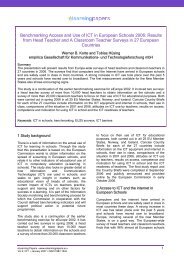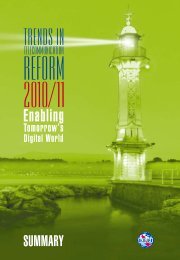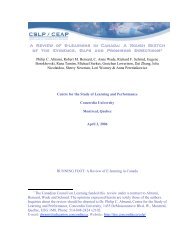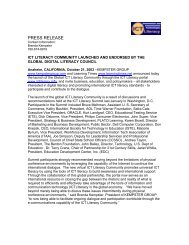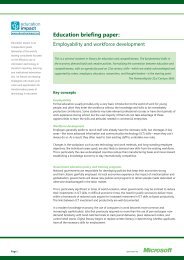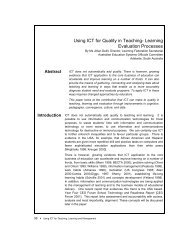147 pages pdf - ICT Digital Literacy
147 pages pdf - ICT Digital Literacy
147 pages pdf - ICT Digital Literacy
You also want an ePaper? Increase the reach of your titles
YUMPU automatically turns print PDFs into web optimized ePapers that Google loves.
Pedagogy & Webagogy -- Ready, Set … TRAIN and FACILITATE!<br />
#520: Use Trivia As A Hook For More Effective Learning<br />
Items of trivia can create a powerful hook for learning. Short, sharp and, sometimes, silly facts<br />
provide our brains with the fun and interest we need to stay connected to the training. We link<br />
these facts to other parts of the content in the same way we would use well placed and highly<br />
memorable graphics. Once the association is made, the picture or the trivia sparks the link to<br />
the content that may have been mundane without it. Thus the hook is made and longer term<br />
memory committed.<br />
Neil Lasher<br />
Trainer1<br />
#521: Invent Ways To Keep Your Audience Involved<br />
Ask for folks to "raise their hands" if they agree with a statement you just made; Ask a question<br />
and ask people to type their answer in Text Chat but not to press send until you say "go"; Have<br />
people click "yes" on the feedback pallet when they can see your pointer on the slide; Be<br />
creative and think of some more ways for learners to participate!<br />
Malee Jones<br />
EDS<br />
#522: Use What Works For The Job At Hand<br />
There's a lot of training that can happen with capturing things through Print Screen, Microsoft<br />
Word, Microsoft Paint … and then sending it out through email.<br />
Linda English<br />
Save The Children<br />
#523: Two Due Dates Are Better Than One<br />
When teaching with an asynchronous discussion board, students often wait until the due date<br />
before posting. Because of this, little time is available for replies, so little discussion occurs. To<br />
allow more time for replies, consider establishing two due dates. The first due date is for an<br />
initial posting, and the second due date is for the end of the discussion. If you have a one-week<br />
discussion period, you could require students to make an initial posting by the third day. With<br />
this approach, everyone has at least three or four days to reply. I do this when I teach online<br />
and have found it really helps, especially near the end of the semester when other time<br />
commitments pull for student attention.<br />
David M. Antonacci<br />
University of Missouri-Kansas City<br />
#524: Use More Than One Channel<br />
I encourage students to form small work groups . . . interact in as many ways as possible . . . behave like a<br />
learning team . . . just as people do in industry teams, where the stakes are much higher.<br />
Pete Edwards, Ph.D.<br />
Adjunct Professor, UD<br />
#525: Get Tough On Students<br />
Instructors need to remind their students to respond to discussion board postings with relevant information.<br />
Often students post responses that are nice or complimentary. This takes a great deal of the other<br />
student's time. Students open all the messages and do not have time to open several that have no<br />
substance. This week's posting to our discussion board in a class that I am taking totaled 209. I estimate<br />
that 40 of these could have been omitted because they really did not say anything new.<br />
Bill Fleckenstein<br />
Bellefonte Area Middle School<br />
701 e-Learning Tips by The MASIE Center www.masie.com 104



